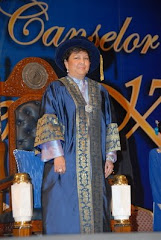A mock viva was held at OUM main campus on April 25, 2010. It was part of a series of meeting organized by the CGS department of OUM to assist current PhD students to understand the process of going through the lonely journey before they can really obtain their doctoral degree.
 Prof. Ghazali (standing, left) and Richard Ng (standing, right) before the start of the mock viva
Prof. Ghazali (standing, left) and Richard Ng (standing, right) before the start of the mock viva Prof. Ghazali was doing the introduction before the start of the mock viva
Prof. Ghazali was doing the introduction before the start of the mock viva
 Richard Ng presenting his slides during the mock viva
Richard Ng presenting his slides during the mock vivaThe mock viva cum meeting session was chaired by OUM PhD Coordinator, Prof. Ghazali and was attended by Prof. Junaidah as the mock external examiner, Prof. Karl Wagner from Applied Science University, Germany, who is also the supervisor for Richard Ng. About 20 PhD students from all over the country attended the session as well.
 Part of the PhD students who attended the session
Part of the PhD students who attended the session Prof. Karl in blue shirt sitting beside the window
Prof. Karl in blue shirt sitting beside the windowIt was a very fruitful mock viva session where the presenter, Richard Ng as well as other students have benefited from the session. After the mock viva, Prof. Junaidah gave a presentation on how to prepare the PhD thesis.
Here are some of the feedback from Sumathi, one of the PhD students who have volunteered to take note during the mock viva: (Thanks to you Sue)
Here are the points that I managed to jot down:
1)H5 = reject the null hypotheses, who are not……(incomplete sentence)
2)Introduction: address the gap of knowledge, it should be addressed in the beginning, Must tell the reader, what triggered the study.
3)Research question present first before literature review. How did you derive the hypotheses. Some thing missing in the models, summarise the importance in the models. Certain variables are important and therefore researcher cannot pick and choose. Do justify.
4)You have presented all the models including the previous studies done. To include local and overseas universities.
5)Methodology – Highlight on adapted instruments. How do you derive 140 to 59, which you dropped and took. Reliability test, no factor analysis result.
6)Hypotheses, to be written in research hypotheses. Not null.
7)Instruments used not from educational setting, make some adjustment or else justify to the faculty of study.
8) A lot of hypotheses, quoting only 1 variable to another. Multiple regression, should highlight the r2 and explain what r2 means.
9) Sampling, big sample i.e. 3,500 students. Explain how 3,500 students segregated at each level, how many students you wanted. Is 300 students okay at each level of year. Each level COULD be different number.
10) Compare the construct of the 4 different levels of students. Do a cross tab at each level.
11) Scale used to be highlighted.
12) Page 25, the table has no number (there is a mistake – the dotted line…..if significant is less than 0.05 used)
13) Some whispers between you and Prof. Ghazali I could not hear. This I managed to capture…he said to identify problem statement, the attrition rate.
14) Question impose by Ms. Lim – why case study only at OUM (it is not a problem), why not other college and institutions. What is the benchmarking, why.not go to other universities to find out
15) In the background of study, justify OUM is the ‘study’. Eg. there are no other university in similar.
16) Research objective, only 1 objective and several sub objectives
17) Definition of risk and non risk. How do you categories risk and non-risk and WHY.
18) CGPA – one of the variables.
After the presentation, Prof. Dr. Junaidah explained on technical report writing.
There are 6 characteristics in effective technical writing:
a) clarity
b) accuracy
c) comprehensiveness
d) accessibility
e) conciseness (less wordy, more contents)
f) correctness (eg. grammar, punctuation, format standard)
The two main components for technical report writing process:
i) audience (technical person/ manager/ general readers)
ii) Purpose (what do you want this document to accomplish)...explain, inform, illustrate, to review, investigate
Devise a strategy on how to explain.
 Lum presenting his mock viva in front of Assoc. Prof. Dr. Nagarajah Lee (seated front right) and 25 other students
Lum presenting his mock viva in front of Assoc. Prof. Dr. Nagarajah Lee (seated front right) and 25 other students Part of the students who attended the mock viva
Part of the students who attended the mock viva











